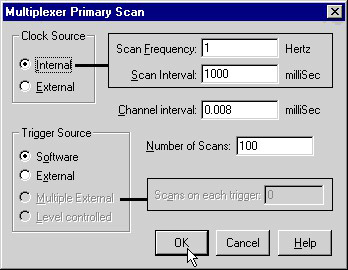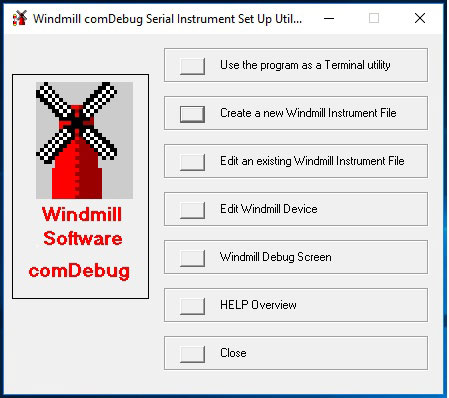Monitor - ISSN 1472-0221
The Newsletter for PC-Based Data Acquisition and Control
Issue 226, June 2017
Welcome to Monitor, the data acquisition and control newsletter. Thanks for subscribing.
You can download this issue of Monitor as a pdf file from https://www.windmill.co.uk/monitor/monitor226.pdf.
Contents
* How to Trigger Data Acquisition
* Your Data Acquisition Questions Answered
* Excel Corner
* Data Acquisition News Round-up
How to Trigger Data Acquisition
Weblink: https://www.windmill.co.uk/trigger-data-acquisition.html
Anything that causes data collection to begin is known as a trigger. It may be as simple as pressing a button in software. Some hardware equipment also generates a trigger signal which needs to be fed directly into the data acquisition interface. This is called an External Trigger.

Using the Windmill SetupIML software
to choose the trigger source
Windmill Software Trigger Options
The Windmill Logger program has several triggering options.
- Start logging when you press a key on the keyboard.
- Start logging when you click a button in the Logger software.
- Start logging when you start up the computer.
- Log only when new data is available from your instrument: when a weight changes on a balance for instance. Even if two items weigh the same, Windmill knows that a change has occurred and doesn't miss a reading.
- Log data only when a channel is in an alarm state, for example when a temperature reading rises above a set point then Logger will start collecting readings.
- Use Excel or other programs to tell Logger to start collecting data.
More sophisticated triggering is available with the Windmill Test Sequence program. It can trigger data acquisition according to the time of day, or, if one or more alarms conditions have been true for a set period of time.
Why use External Triggers?
External triggers let you synchronise data acquisition with external events. This has several benefits.
- You reduce the amount of data collected.
- Some instruments like spectrometers have their own timing control and can use triggers to tell the acquisition interface to start collecting data.
- Acquisition can automatically start when, for instance, you switch on a machine to be monitored.
- You need only to collect data under specific conditions. For example, you might wish to record what happens to a test rig when an input signal goes outside pre-defined limits.
What do the External Trigger Specifications Mean?
Product literature from data acquisition hardware manufacturers will tell you whether their equipment will accept external triggers, and what form these triggers should take.
- Positive Edge or Negative Edge Triggering
- The system may be triggered when the external signal passes from a low to a high state: positive edge triggering. Alternatively, it might wait for the signal to change from a high to a low state: negative edge triggering.
- Digital Triggers
- A trigger can be an analogue or a digital signal. A digital trigger input may be listed as TTL or CMOS compatible. TTL (transistor-transistor logic) is the most commonly used. When the trigger input signal is between 0 and 0.8 V it is considered low, when between 2.0 and 5.5 V high.
- Analogue Triggers
- Analogue triggers let you use, for example, changes in temperature or strain to initiate sampling. You can program the hardware to be triggered (or to cause a trigger) when an analogue input crosses your chosen threshold. With a flexible system you might set the trigger level as a percentage of the analogue input voltage. If the range was 0-10 V, setting 50 percent would cause a trigger when the signal crossed the 5 V threshold. This is useful when you can choose the hardware range.
- Gated Triggering
-
You can not only start sampling with an external
trigger, you can also stop it. When the trigger input
leaves the "stop" state, sampling begins. It
continues until the trigger signal returns to the
stop state. With digital triggers a low signal might
be the stop state and a high signal the start state.
For analogue triggers the hardware would need two trigger inputs. One trigger might occur when a high limit is passed with a positive slope (low to high) and one when a low limit is passed with a negative slope (high to low). This lets you record, for example, what happens to a test-rig when an input signal transgresses pre-defined limits.
- Trigger Pulse Width
- This is the minimum time that the change in trigger signal must be sustained before sampling starts, or stop. Typically this might be 1 millisecond.
- Trigger Delay
- Some hardware lets you specify a pause between receiving the trigger and sampling starting. This is useful if the software needs to prepare itself to receive data. The delay might be around 20 millisecond.
- Pre-Trigger Data
- Some hardware can collect data before the trigger arrives. You specify how much of this should be retained. This way you can record events leading up to the trigger.
For direct hardware triggering the Microlink 770 transient capture unit accepts and can initiate external triggers.
For more details of these and other hardware options see https://windmillsoft.com/daqshop/ or contact sales@biodataltd.com.
Your Data Acquisition Questions Answered: Why am I getting "Replace with your own IMD file" in Windmill?
Weblink: https://www.windmill.co.uk/comiml_ts.html
Question
My Lippke 4000 machine is connected via RS232 to the PC. The communication works, ComDebug receives the information. When I now run ComIML, I choose Add ComIML Serial Instrument handler. It creates a new device - "None: Empty file - replace with your own IMD file".
Answer
You need to save your settings in ComDebug and create a Windmill Device there. In ComDebug's opening screen click Edit Windmill Device.


To download a trial of the Windmill data acquisition programs go to https://www.windmill.co.uk/jsarrpsrr.htm.
Excel Corner: Quickly adding items to a Formula
Have to add several, non-contiguous, cell references to a formula? For example, you want to average several values. To do this you would use the formula
=Average(A3, B7, C5)
You can get Excel to automatically add the commas between cell references for you. Just hold down the Ctrl key whilst clicking the cells you want to reference. Simple.
For more Excel tips see https://www.windmill.co.uk/excel/
DAQ News Round-up
Welcome to our round-up of the data acquisition and control news. If you would like to receive more timely DAQ news updates then follow us on Twitter - @DataAcquisition - or grab our rss feed.
Artificial whisky taster has the palate of a connoisseur
A technique involving fluorescent dyes can tell the age and origin of different spirits, and a fake from the genuine article - much like a whisky taster's tongue.
Source: New Scientist
https://www.newscientist.com/
New sensors exactly measure pressures at 400 oC
Many industrial processes depend on exact pressure gauges. The SOI high-pressure sensors (silicon-on-insulator) makes this exact monitoring possible for processes operating at temperatures of up to 400 oC.
Source: Fraunhofer IZM
https://www.izm.fraunhofer.de/
Tactile sensor gives robots new capabilities
GelSight technology lets robots gauge objects' hardness and manipulate small tools.
Source: MIT
http://news.mit.edu/
Drone Uses Wi-Fi for 3-D Through-Wall Imaging
Researchers demonstrate three-dimensional imaging through walls using wireless signal.
Source: Senors Mag
http://www.sensorsmag.com/
Printed sensors monitor tire wear in real time
Carbon nanotubes bring tire wear monitoring into the car
Source: Duke University
https://www.eurekalert.org/pub_releases/2017-06/du-psm061417.php/
* Copyright Windmill Software Ltd
* Reprinting permitted with this notice included
* For more articles see https://www.windmill.co.uk/
We are happy for you to copy and distribute this
newsletter, and use extracts from it on your own web
site or other publication, providing the above notice
is included and a link back to our website is in place.
For previous issues by subject see https://www.windmill.co.uk/monitorindex.html
DOWNLOAD DATA ACQUISITION SOFTWARE
As a thank you for subscribing we offer you the ComDebug data logging and Com port trouble-shooting software. Log data over RS232, RS422, RS485 or Modbus. Also included is a month's trial of the Windmill 7 logging, charting and control programs.
SUBSCRIBING OR CANCELLING SUBSCRIPTION Visit https://www.windmill.co.uk/newsletter.html and add or remove your e-mail address.
Windmill Software Ltd, PO Box 58, North District Office,
Manchester, M8 8QR, UK
Telephone: +44 (0)161 834 6688
Facsimile: +44 (0)161 833 2190
E-mail: monitor@windmillsoft.com
https://www.windmill.co.uk/
https://www.windmillsoft.com/
